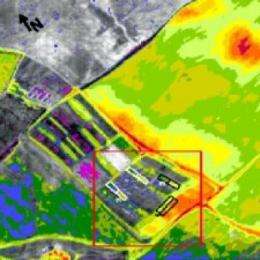Sensing disasters from space

One small step for mankind is now a leap for averting natural and man-made disasters on earth.
New Tel Aviv University technology combines sophisticated sensors in orbit with sensors on the ground and in the air to create a "Hyperspectral Remote Sensor" (HRS). It can give advance warnings about water contamination after a forest fire, alert authorities of a pollution spill long before a red flag is raised on earth, or tell people in China where a monsoon will strike.
Prof. Eyal Ben-Dor of Tel Aviv University's Department of Geography describes his team's HRS technology as a combination of physical, chemical and optical disciplines. "When a devastating forest fire hits the Hollywood Hills, for example, we can see from space how the mineralogy of the soil has changed," he explains. "Because of these changes, the next rainstorm may wash out all the buildings or leach contaminants into the soil. With our new tool, we can advise on how to contain the pollutants after the fire, and warn if there is a risk for landslides."
Details on new applications of this technology were presented recently in several leading journals including Soil Science Society of American Journals, Soil Science Journal and the International Journal of Remote Sensing.
Putting a price on dirt
HRS provides information useful to property developers as well. It can offer a soil profile map with detailed information for contractors, farmers or vintners interested in making major land purchase deals or managing existing ones. It can also indicate where water runoff should be directed and what minerals may be lacking in a given parcel of land.
"Water is an expensive commodity today," says Prof. Ben Dor. "Knowing how to better manage water resources is a top priority for states like California, and our new tool could help them do that."
Today, it can take years before authorities can detect chemicals that can compromise our health. For example, about 90% of all gas stations leak contaminants into the soil, says Prof. Ben-Dor. His new HRS can monitor gas stations and identify problematic areas. "Our space sensors combined with ground measurements and GPS data will be able to detect and map hydrocarbon contamination in real time. Within a year, we'll be able to identify these problematic areas far more quickly than with traditional methods," he says.
Seeing where Earth takes the heat
The HRS simultaneously acquires hundreds of optical images, each from a different frequency, that enable a "spectral assessment" from distances high in the air via airplanes and in orbit using satellites. This raw data is then processed by Prof. Ben Dor and his team to yield sophisticated thematic maps. "These are not regular maps at all," says Prof. Ben-Dor. "We are combining properties from the physical, chemical and optical worlds, using all the latest technologies available from these fields. Ours is one of a few leading teams in the world exploring this novel way of mapping earth."
These "soil maps" supply a bigger picture. Water bodies and sediment runoff in California. A small soil patch in a California forest after a fire. Impending monsoons and floods in China. Contaminants surrounding a factory. All these can literally be "seen" from space with the HRS.
Previous research by Prof. Ben-Dor, which focused on mapping urban heat islands from space, is now regularly used by cities and urban planners to develop projects such as "green" roofs or new parks.
Source: Tel Aviv University (news : web)
















